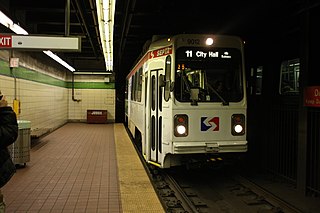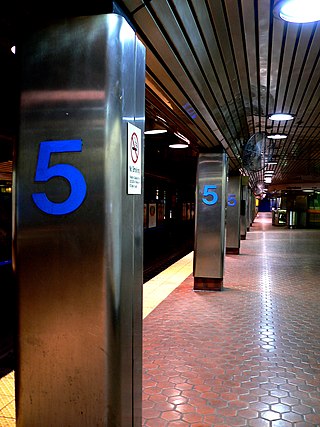
The Broad Street Line (BSL), also known as the Broad Street subway (BSS), Orange Line, or Broad Line, is a subway line owned by the city of Philadelphia and operated by the Southeastern Pennsylvania Transportation Authority (SEPTA). The line runs primarily north-south from the Fern Rock Transportation Center in North Philadelphia through Center City Philadelphia to NRG station at Pattison Avenue in South Philadelphia; the latter station provides access to the stadiums and arenas for the city's major professional sports teams at the South Philadelphia Sports Complex, about a quarter mile away. It is named for Broad Street, under which the line runs for almost its entire length. In 2024, as part of the SEPTA Metro plan, the Broad Street Line is undergoing a rebrand to the service letter B.

The Market–Frankford Line (MFL), currently rebranding as the L, is a rapid transit line in the SEPTA Metro network in Philadelphia, Pennsylvania, United States. The MFL runs from the 69th Street Transportation Center in Upper Darby, just outside of West Philadelphia, through Center City Philadelphia to the Frankford Transportation Center in Near Northeast Philadelphia. Starting in 2024, the line was rebranded as the "L" as part of the implementation of SEPTA Metro, wherein line names are simplified to a single letter.

8th Street station is a subway station complex in Philadelphia, Pennsylvania, at the intersection of 8th Street and Market Street in Center City. It is served by SEPTA's Market–Frankford and Broad–Ridge Spur lines, as well as the PATCO Speedline. The entire complex is owned by SEPTA, while the PATCO areas are leased by the Delaware River Port Authority, which operates that line. 8th Street is the only station in Philadelphia where these three subway lines interchange.

Suburban Station is an art deco office building and underground commuter rail station in Penn Center in Philadelphia. Its official SEPTA address is 16th Street and JFK Boulevard. The station is owned and operated by SEPTA and is one of the three core Center City stations on the SEPTA Regional Rail and one of the busiest stations in the Regional Rail System.

The SEPTA subway–surface trolley lines are a collection of five SEPTA trolley lines that operate on street-level tracks in West Philadelphia and Delaware County, Pennsylvania, and also underneath Market Street in Philadelphia's Center City. The lines, Routes 10, 11, 13, 34, and 36, collectively operate on about 39.6 miles (63.7 km) of route.

Jefferson Station is an underground SEPTA Regional Rail station located on Market Street in Philadelphia, Pennsylvania. It is the easternmost of the three Center City stations of the SEPTA Regional Rail system and is part of the Center City Commuter Connection, which connects the former Penn Central commuter lines with the former Reading Company commuter lines. In 2014, the station saw approximately 26,000 passengers every weekday.

5th Street/Independence Hall station is a subway station in Philadelphia, Pennsylvania at the intersection of 5th and Market Street served by SEPTA's Market-Frankford Line. The station serves multiple notable Philadelphia landmarks including Independence Hall, the Liberty Bell, the National Constitution Center, the National Museum of American Jewish History, and the Philadelphia Bourse.

11th Street station is a subway station in Philadelphia, Pennsylvania at the intersection of 11th Street and Market Street in Center City. It is served by SEPTA's Market-Frankford Line and provides a connection to SEPTA Regional Rail at Jefferson Station.

15th Street station is a subway station in Philadelphia. It is served by SEPTA's Market–Frankford Line and all routes of the subway–surface trolley lines. A free interchange also provides access to the Broad Street Line at City Hall station, which is connected to 15th Street by the Downtown Link underground concourse. The concourse also connects to Regional Rail lines at Suburban Station. It is the busiest station on the Market–Frankford Line, with 29,905 boardings on an average weekday.

SEPTA Route 10, also known as the Lancaster Avenue Line, to be known as the T1 after rebrand, is a trolley line operated by the Southeastern Pennsylvania Transportation Authority (SEPTA) that connects the 13th Street station in Center City Philadelphia, Pennsylvania, to the 63rd Street–Malvern Avenue station in the Overbrook section of West Philadelphia. It is one out of five lines that is part of the SEPTA's subway–surface trolley system and is 11.6 mi (18.7 km) long. It is the least used subway-surface trolley line, but unlike Route 11, the most used subway-surface trolley line, it has overnight service.

13th Street station is a SEPTA subway station in Philadelphia, Pennsylvania, located under Market Street between 13th and Juniper Streets in Center City. The station serves the Market–Frankford Line and is the eastern terminal station for all five routes of the subway–surface trolley lines.

Walnut–Locust/Avenue of the Arts is a subway station on SEPTA's Broad Street Line in Philadelphia, Pennsylvania. The station is located between Walnut Street and Locust Street at 200 South Broad Street in the Avenue of the Arts district of Center City, Philadelphia.

Spring Garden station is a SEPTA rapid transit station in Philadelphia, Pennsylvania, United States, on the Market–Frankford Line. It is located on Spring Garden Street between 2nd and Front streets in the Northern Liberties neighborhood. It is the westernmost station of the Frankford Elevated section of the line and the last westbound station before trains enter Center City Philadelphia.

Millbourne station is a rapid transit station on SEPTA's Market-Frankford Line, located adjacent east of an intersection between Millbourne Avenue and Wister Drive in Millbourne, Pennsylvania. It is one of two ground-level stops on the Market–Frankford Line, as well as one of two SEPTA rapid transit stations located outside the Philadelphia city limits. The station lies two blocks north of the line's namesake street.

The 63rd Street station is an elevated rapid transit station in Philadelphia, Pennsylvania, served by SEPTA's Market–Frankford Line trains. Located at the intersection of 63rd and Market Streets in the Haddington neighborhood of West Philadelphia, it is the westernmost stop on the line within the Philadelphia city limits.

60th Street station is an elevated rapid transit station on SEPTA's Market–Frankford Line, located at the intersection of 60th Street and Market Street in Philadelphia, Pennsylvania. The station straddles the line between two West Philadelphia neighborhoods, Haddington to the north and Cobbs Creek.

40th Street station is an underground station on the SEPTA Market-Frankford Line, located the intersection of 40th Street and Market Street in Philadelphia, Pennsylvania, on the line between the Spruce Hill and Powelton Village neighborhoods in the University City District of West Philadelphia. The station serves a major shopping corridor of West Philadelphia on 40th Street, as well as the campus of the University of Pennsylvania, which lies three blocks south of the station.

34th Street station is an underground station on the SEPTA Market-Frankford Line, located at the intersection of 34th Street and Market Street in Philadelphia, Pennsylvania, in the University City neighborhood of West Philadelphia. The station is on the Drexel University campus, adjacent to the Daskalakis Athletic Center, and near the University of Pennsylvania campus and the University City Science Center.

Drexel Station at 30th Street is an underground SEPTA Metro station in Philadelphia. It is located on Market Street between 30th and 31st Streets in the University City neighborhood, adjacent to 30th Street Station and Drexel University. The station features four tracks – the inner pair serving the L and the outer pair for the T.

30th Street Station, officially William H. Gray III 30th Street Station, is a major intermodal transit station in Philadelphia, Pennsylvania, United States. It is metropolitan Philadelphia's main railroad station and a major stop on Amtrak's Northeast and Keystone corridors.































